IG003 Climate for Creativity: Workplace Analysis and Recommendations
VerifiedAdded on 2023/03/31
|8
|2108
|436
Report
AI Summary
This report, submitted by a student, examines the concept of climate for creativity within an organization. It analyzes three workplace scenarios, identifying both positive and negative attributes that impact creative culture and employee motivation. The analysis covers various aspects, including team-building, resource allocation, and communication strategies. The report explores how specific actions, such as external team lunches, brainstorming sessions, and internal promotions, influence the creative environment. Additionally, it discusses initiatives to transform the workplace and promote creativity, including individual and organizational approaches such as rewarding creativity, allowing time for creative thinking, and encouraging teamwork. The report concludes by emphasizing the importance of fostering an open and innovative environment to drive organizational success and enhance employee relationships. The report is based on the IG003 assignment brief and rubric from Walden University.
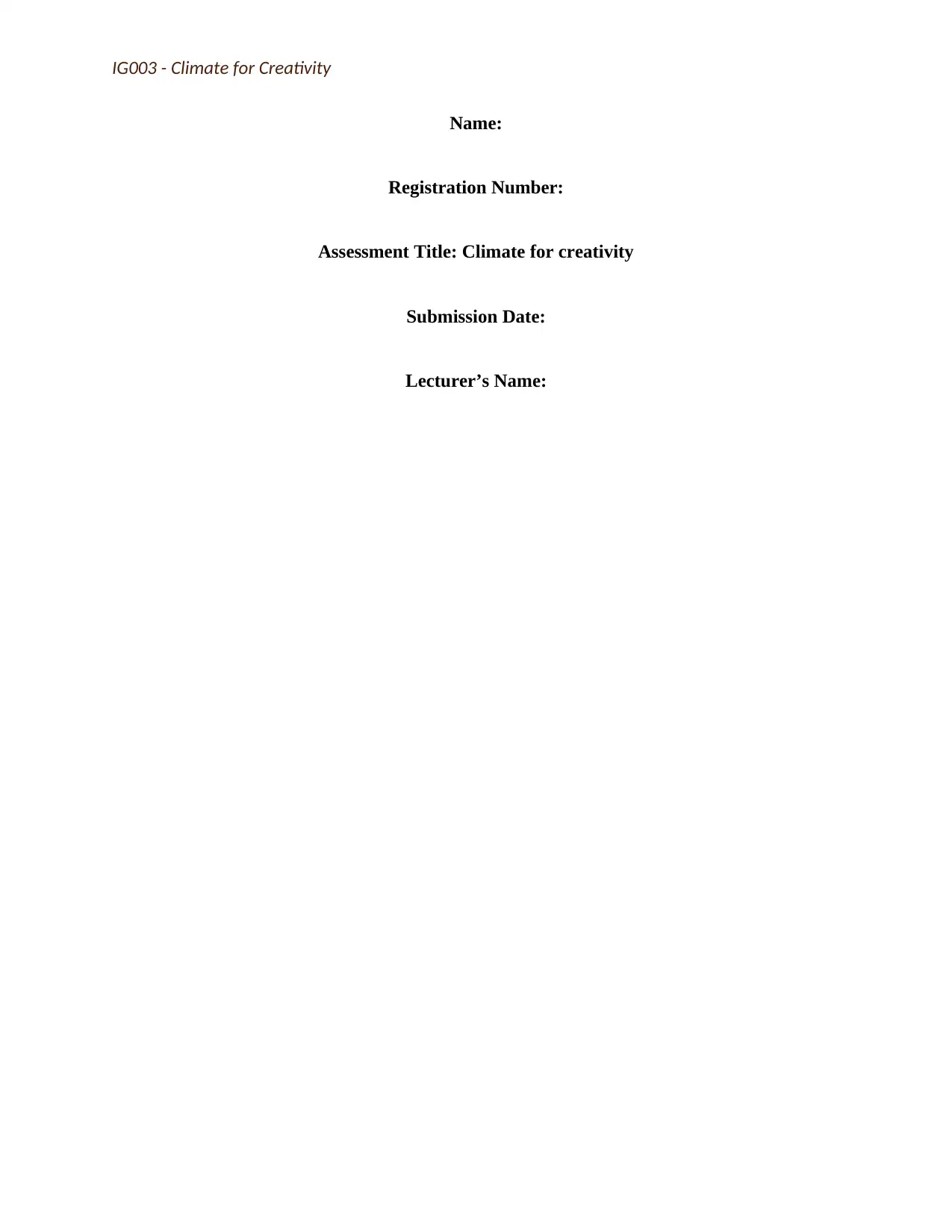
IG003 - Climate for Creativity
Name:
Registration Number:
Assessment Title: Climate for creativity
Submission Date:
Lecturer’s Name:
Name:
Registration Number:
Assessment Title: Climate for creativity
Submission Date:
Lecturer’s Name:
Paraphrase This Document
Need a fresh take? Get an instant paraphrase of this document with our AI Paraphraser
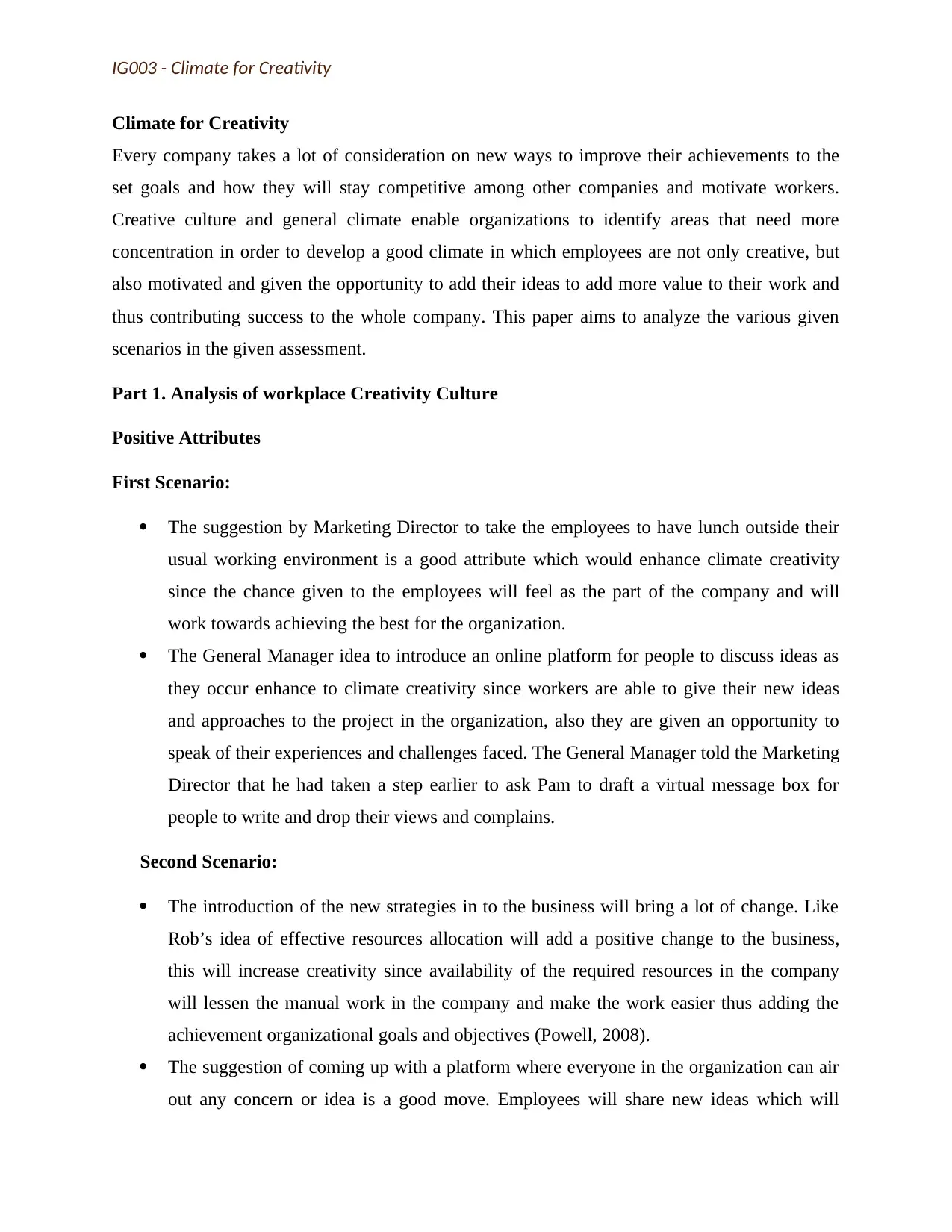
IG003 - Climate for Creativity
Climate for Creativity
Every company takes a lot of consideration on new ways to improve their achievements to the
set goals and how they will stay competitive among other companies and motivate workers.
Creative culture and general climate enable organizations to identify areas that need more
concentration in order to develop a good climate in which employees are not only creative, but
also motivated and given the opportunity to add their ideas to add more value to their work and
thus contributing success to the whole company. This paper aims to analyze the various given
scenarios in the given assessment.
Part 1. Analysis of workplace Creativity Culture
Positive Attributes
First Scenario:
The suggestion by Marketing Director to take the employees to have lunch outside their
usual working environment is a good attribute which would enhance climate creativity
since the chance given to the employees will feel as the part of the company and will
work towards achieving the best for the organization.
The General Manager idea to introduce an online platform for people to discuss ideas as
they occur enhance to climate creativity since workers are able to give their new ideas
and approaches to the project in the organization, also they are given an opportunity to
speak of their experiences and challenges faced. The General Manager told the Marketing
Director that he had taken a step earlier to ask Pam to draft a virtual message box for
people to write and drop their views and complains.
Second Scenario:
The introduction of the new strategies in to the business will bring a lot of change. Like
Rob’s idea of effective resources allocation will add a positive change to the business,
this will increase creativity since availability of the required resources in the company
will lessen the manual work in the company and make the work easier thus adding the
achievement organizational goals and objectives (Powell, 2008).
The suggestion of coming up with a platform where everyone in the organization can air
out any concern or idea is a good move. Employees will share new ideas which will
Climate for Creativity
Every company takes a lot of consideration on new ways to improve their achievements to the
set goals and how they will stay competitive among other companies and motivate workers.
Creative culture and general climate enable organizations to identify areas that need more
concentration in order to develop a good climate in which employees are not only creative, but
also motivated and given the opportunity to add their ideas to add more value to their work and
thus contributing success to the whole company. This paper aims to analyze the various given
scenarios in the given assessment.
Part 1. Analysis of workplace Creativity Culture
Positive Attributes
First Scenario:
The suggestion by Marketing Director to take the employees to have lunch outside their
usual working environment is a good attribute which would enhance climate creativity
since the chance given to the employees will feel as the part of the company and will
work towards achieving the best for the organization.
The General Manager idea to introduce an online platform for people to discuss ideas as
they occur enhance to climate creativity since workers are able to give their new ideas
and approaches to the project in the organization, also they are given an opportunity to
speak of their experiences and challenges faced. The General Manager told the Marketing
Director that he had taken a step earlier to ask Pam to draft a virtual message box for
people to write and drop their views and complains.
Second Scenario:
The introduction of the new strategies in to the business will bring a lot of change. Like
Rob’s idea of effective resources allocation will add a positive change to the business,
this will increase creativity since availability of the required resources in the company
will lessen the manual work in the company and make the work easier thus adding the
achievement organizational goals and objectives (Powell, 2008).
The suggestion of coming up with a platform where everyone in the organization can air
out any concern or idea is a good move. Employees will share new ideas which will
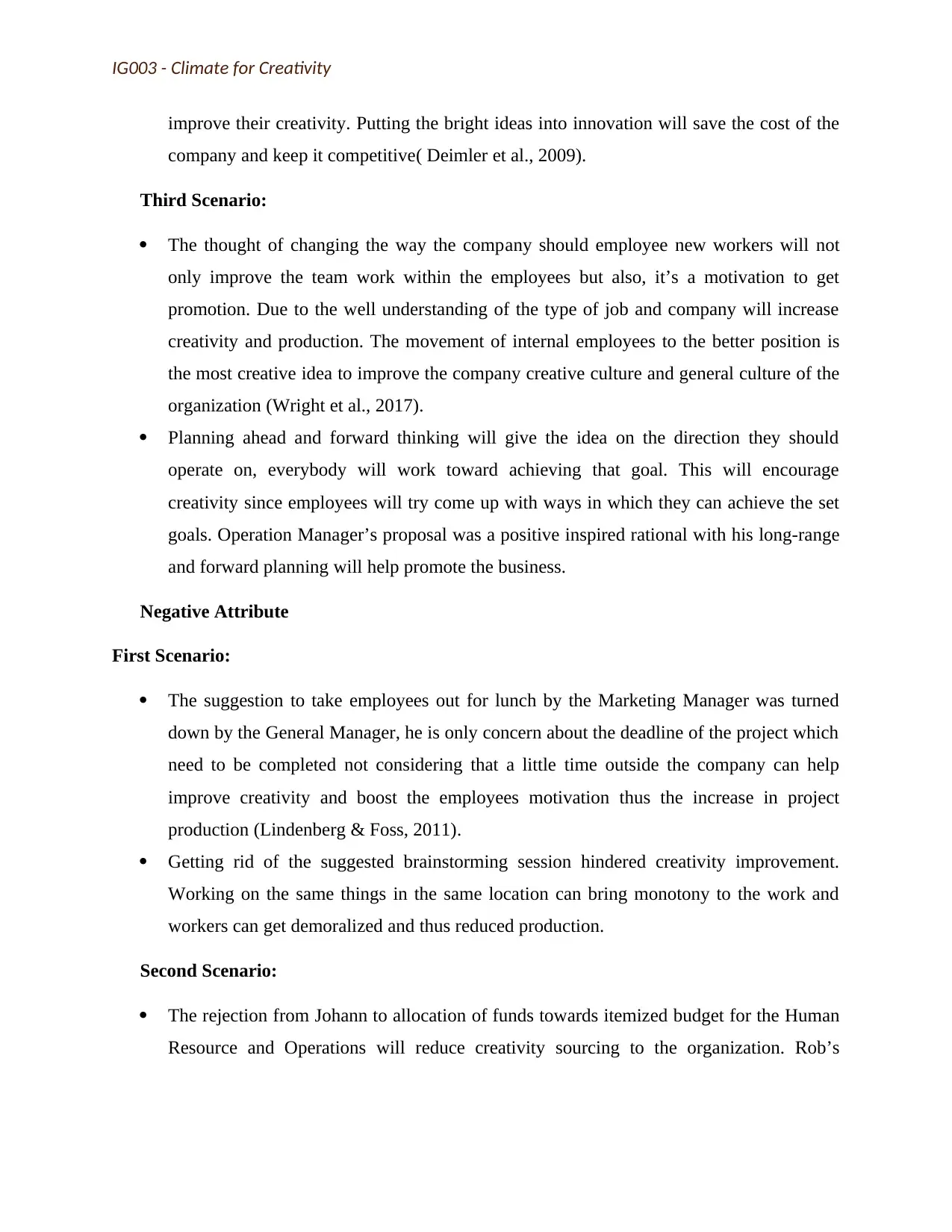
IG003 - Climate for Creativity
improve their creativity. Putting the bright ideas into innovation will save the cost of the
company and keep it competitive( Deimler et al., 2009).
Third Scenario:
The thought of changing the way the company should employee new workers will not
only improve the team work within the employees but also, it’s a motivation to get
promotion. Due to the well understanding of the type of job and company will increase
creativity and production. The movement of internal employees to the better position is
the most creative idea to improve the company creative culture and general culture of the
organization (Wright et al., 2017).
Planning ahead and forward thinking will give the idea on the direction they should
operate on, everybody will work toward achieving that goal. This will encourage
creativity since employees will try come up with ways in which they can achieve the set
goals. Operation Manager’s proposal was a positive inspired rational with his long-range
and forward planning will help promote the business.
Negative Attribute
First Scenario:
The suggestion to take employees out for lunch by the Marketing Manager was turned
down by the General Manager, he is only concern about the deadline of the project which
need to be completed not considering that a little time outside the company can help
improve creativity and boost the employees motivation thus the increase in project
production (Lindenberg & Foss, 2011).
Getting rid of the suggested brainstorming session hindered creativity improvement.
Working on the same things in the same location can bring monotony to the work and
workers can get demoralized and thus reduced production.
Second Scenario:
The rejection from Johann to allocation of funds towards itemized budget for the Human
Resource and Operations will reduce creativity sourcing to the organization. Rob’s
improve their creativity. Putting the bright ideas into innovation will save the cost of the
company and keep it competitive( Deimler et al., 2009).
Third Scenario:
The thought of changing the way the company should employee new workers will not
only improve the team work within the employees but also, it’s a motivation to get
promotion. Due to the well understanding of the type of job and company will increase
creativity and production. The movement of internal employees to the better position is
the most creative idea to improve the company creative culture and general culture of the
organization (Wright et al., 2017).
Planning ahead and forward thinking will give the idea on the direction they should
operate on, everybody will work toward achieving that goal. This will encourage
creativity since employees will try come up with ways in which they can achieve the set
goals. Operation Manager’s proposal was a positive inspired rational with his long-range
and forward planning will help promote the business.
Negative Attribute
First Scenario:
The suggestion to take employees out for lunch by the Marketing Manager was turned
down by the General Manager, he is only concern about the deadline of the project which
need to be completed not considering that a little time outside the company can help
improve creativity and boost the employees motivation thus the increase in project
production (Lindenberg & Foss, 2011).
Getting rid of the suggested brainstorming session hindered creativity improvement.
Working on the same things in the same location can bring monotony to the work and
workers can get demoralized and thus reduced production.
Second Scenario:
The rejection from Johann to allocation of funds towards itemized budget for the Human
Resource and Operations will reduce creativity sourcing to the organization. Rob’s
⊘ This is a preview!⊘
Do you want full access?
Subscribe today to unlock all pages.

Trusted by 1+ million students worldwide
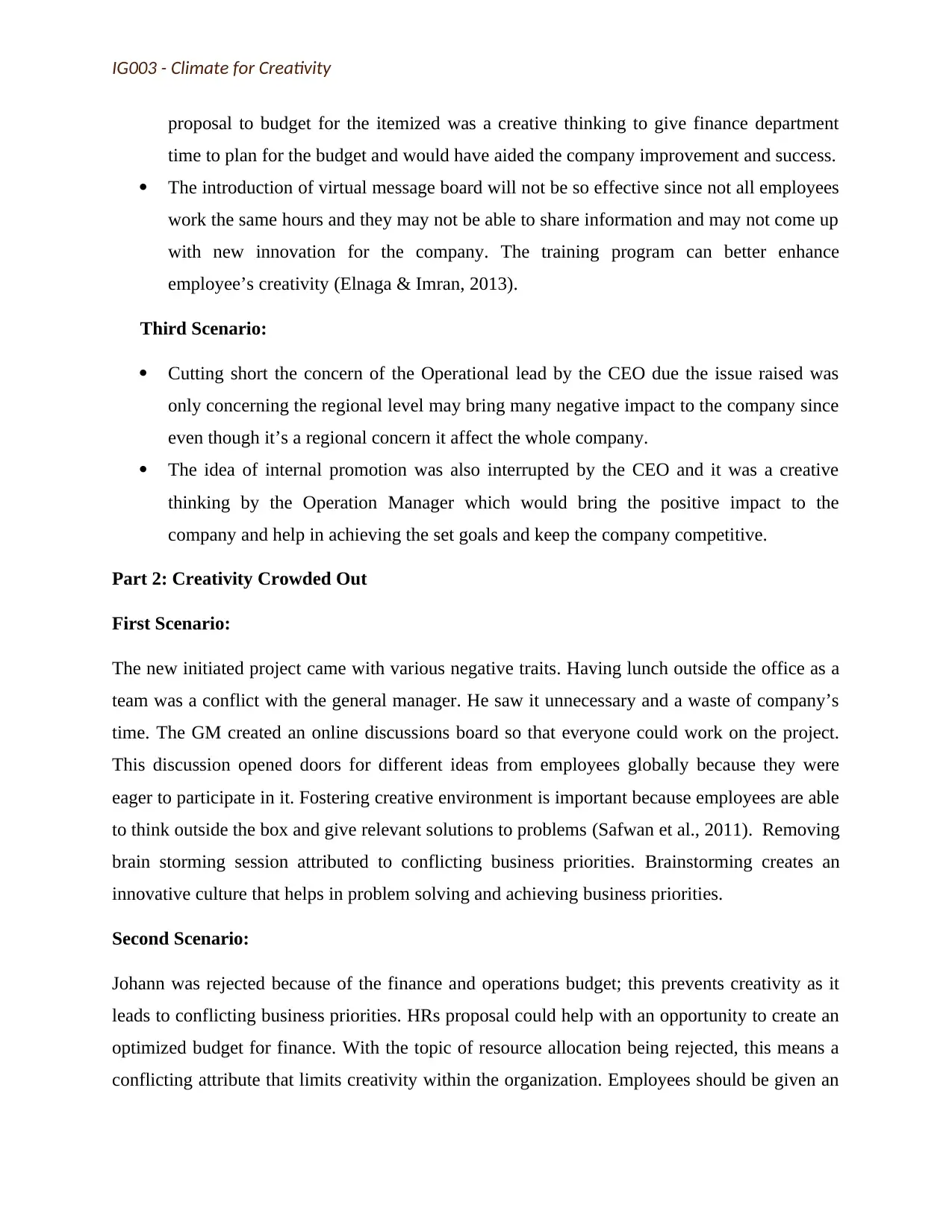
IG003 - Climate for Creativity
proposal to budget for the itemized was a creative thinking to give finance department
time to plan for the budget and would have aided the company improvement and success.
The introduction of virtual message board will not be so effective since not all employees
work the same hours and they may not be able to share information and may not come up
with new innovation for the company. The training program can better enhance
employee’s creativity (Elnaga & Imran, 2013).
Third Scenario:
Cutting short the concern of the Operational lead by the CEO due the issue raised was
only concerning the regional level may bring many negative impact to the company since
even though it’s a regional concern it affect the whole company.
The idea of internal promotion was also interrupted by the CEO and it was a creative
thinking by the Operation Manager which would bring the positive impact to the
company and help in achieving the set goals and keep the company competitive.
Part 2: Creativity Crowded Out
First Scenario:
The new initiated project came with various negative traits. Having lunch outside the office as a
team was a conflict with the general manager. He saw it unnecessary and a waste of company’s
time. The GM created an online discussions board so that everyone could work on the project.
This discussion opened doors for different ideas from employees globally because they were
eager to participate in it. Fostering creative environment is important because employees are able
to think outside the box and give relevant solutions to problems (Safwan et al., 2011). Removing
brain storming session attributed to conflicting business priorities. Brainstorming creates an
innovative culture that helps in problem solving and achieving business priorities.
Second Scenario:
Johann was rejected because of the finance and operations budget; this prevents creativity as it
leads to conflicting business priorities. HRs proposal could help with an opportunity to create an
optimized budget for finance. With the topic of resource allocation being rejected, this means a
conflicting attribute that limits creativity within the organization. Employees should be given an
proposal to budget for the itemized was a creative thinking to give finance department
time to plan for the budget and would have aided the company improvement and success.
The introduction of virtual message board will not be so effective since not all employees
work the same hours and they may not be able to share information and may not come up
with new innovation for the company. The training program can better enhance
employee’s creativity (Elnaga & Imran, 2013).
Third Scenario:
Cutting short the concern of the Operational lead by the CEO due the issue raised was
only concerning the regional level may bring many negative impact to the company since
even though it’s a regional concern it affect the whole company.
The idea of internal promotion was also interrupted by the CEO and it was a creative
thinking by the Operation Manager which would bring the positive impact to the
company and help in achieving the set goals and keep the company competitive.
Part 2: Creativity Crowded Out
First Scenario:
The new initiated project came with various negative traits. Having lunch outside the office as a
team was a conflict with the general manager. He saw it unnecessary and a waste of company’s
time. The GM created an online discussions board so that everyone could work on the project.
This discussion opened doors for different ideas from employees globally because they were
eager to participate in it. Fostering creative environment is important because employees are able
to think outside the box and give relevant solutions to problems (Safwan et al., 2011). Removing
brain storming session attributed to conflicting business priorities. Brainstorming creates an
innovative culture that helps in problem solving and achieving business priorities.
Second Scenario:
Johann was rejected because of the finance and operations budget; this prevents creativity as it
leads to conflicting business priorities. HRs proposal could help with an opportunity to create an
optimized budget for finance. With the topic of resource allocation being rejected, this means a
conflicting attribute that limits creativity within the organization. Employees should be given an
Paraphrase This Document
Need a fresh take? Get an instant paraphrase of this document with our AI Paraphraser
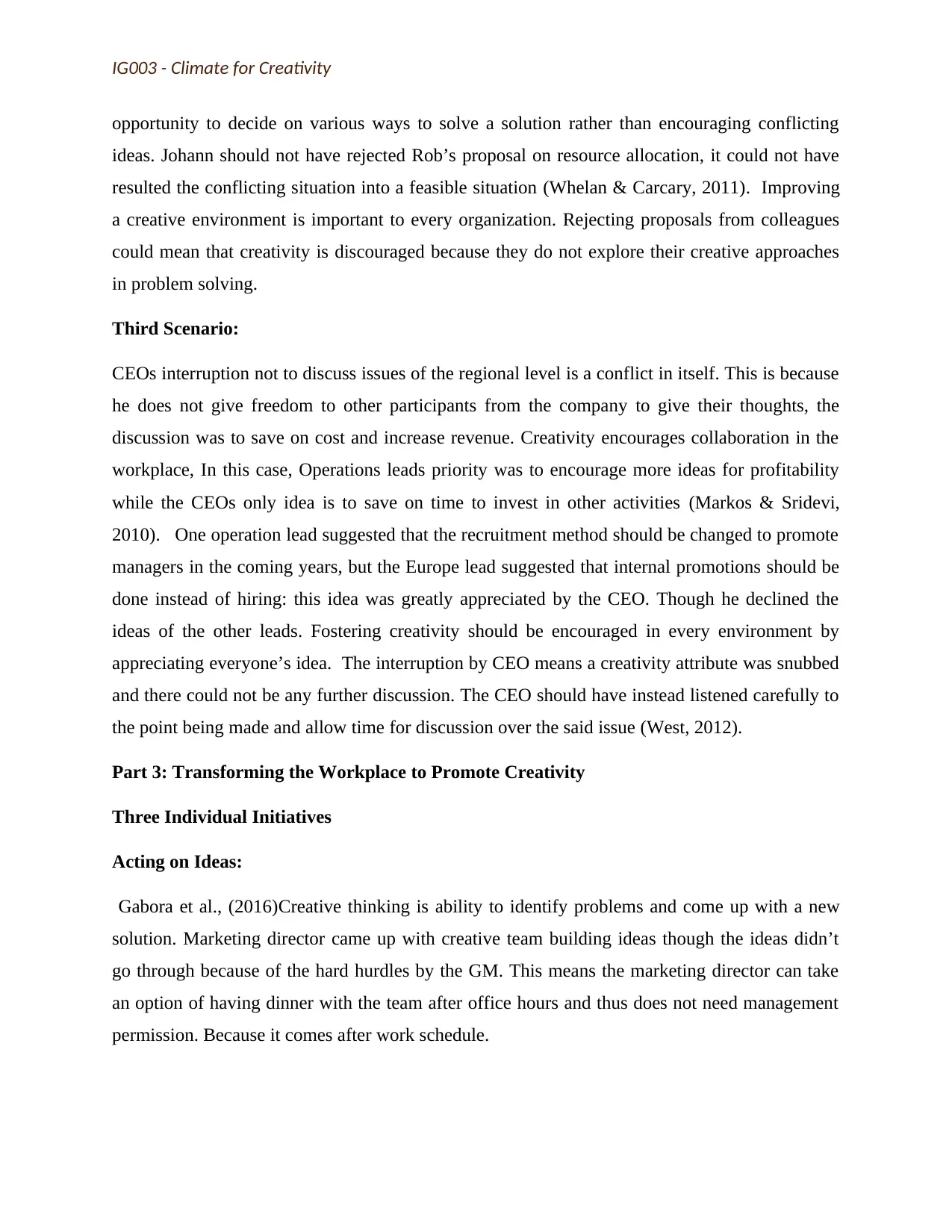
IG003 - Climate for Creativity
opportunity to decide on various ways to solve a solution rather than encouraging conflicting
ideas. Johann should not have rejected Rob’s proposal on resource allocation, it could not have
resulted the conflicting situation into a feasible situation (Whelan & Carcary, 2011). Improving
a creative environment is important to every organization. Rejecting proposals from colleagues
could mean that creativity is discouraged because they do not explore their creative approaches
in problem solving.
Third Scenario:
CEOs interruption not to discuss issues of the regional level is a conflict in itself. This is because
he does not give freedom to other participants from the company to give their thoughts, the
discussion was to save on cost and increase revenue. Creativity encourages collaboration in the
workplace, In this case, Operations leads priority was to encourage more ideas for profitability
while the CEOs only idea is to save on time to invest in other activities (Markos & Sridevi,
2010). One operation lead suggested that the recruitment method should be changed to promote
managers in the coming years, but the Europe lead suggested that internal promotions should be
done instead of hiring: this idea was greatly appreciated by the CEO. Though he declined the
ideas of the other leads. Fostering creativity should be encouraged in every environment by
appreciating everyone’s idea. The interruption by CEO means a creativity attribute was snubbed
and there could not be any further discussion. The CEO should have instead listened carefully to
the point being made and allow time for discussion over the said issue (West, 2012).
Part 3: Transforming the Workplace to Promote Creativity
Three Individual Initiatives
Acting on Ideas:
Gabora et al., (2016)Creative thinking is ability to identify problems and come up with a new
solution. Marketing director came up with creative team building ideas though the ideas didn’t
go through because of the hard hurdles by the GM. This means the marketing director can take
an option of having dinner with the team after office hours and thus does not need management
permission. Because it comes after work schedule.
opportunity to decide on various ways to solve a solution rather than encouraging conflicting
ideas. Johann should not have rejected Rob’s proposal on resource allocation, it could not have
resulted the conflicting situation into a feasible situation (Whelan & Carcary, 2011). Improving
a creative environment is important to every organization. Rejecting proposals from colleagues
could mean that creativity is discouraged because they do not explore their creative approaches
in problem solving.
Third Scenario:
CEOs interruption not to discuss issues of the regional level is a conflict in itself. This is because
he does not give freedom to other participants from the company to give their thoughts, the
discussion was to save on cost and increase revenue. Creativity encourages collaboration in the
workplace, In this case, Operations leads priority was to encourage more ideas for profitability
while the CEOs only idea is to save on time to invest in other activities (Markos & Sridevi,
2010). One operation lead suggested that the recruitment method should be changed to promote
managers in the coming years, but the Europe lead suggested that internal promotions should be
done instead of hiring: this idea was greatly appreciated by the CEO. Though he declined the
ideas of the other leads. Fostering creativity should be encouraged in every environment by
appreciating everyone’s idea. The interruption by CEO means a creativity attribute was snubbed
and there could not be any further discussion. The CEO should have instead listened carefully to
the point being made and allow time for discussion over the said issue (West, 2012).
Part 3: Transforming the Workplace to Promote Creativity
Three Individual Initiatives
Acting on Ideas:
Gabora et al., (2016)Creative thinking is ability to identify problems and come up with a new
solution. Marketing director came up with creative team building ideas though the ideas didn’t
go through because of the hard hurdles by the GM. This means the marketing director can take
an option of having dinner with the team after office hours and thus does not need management
permission. Because it comes after work schedule.
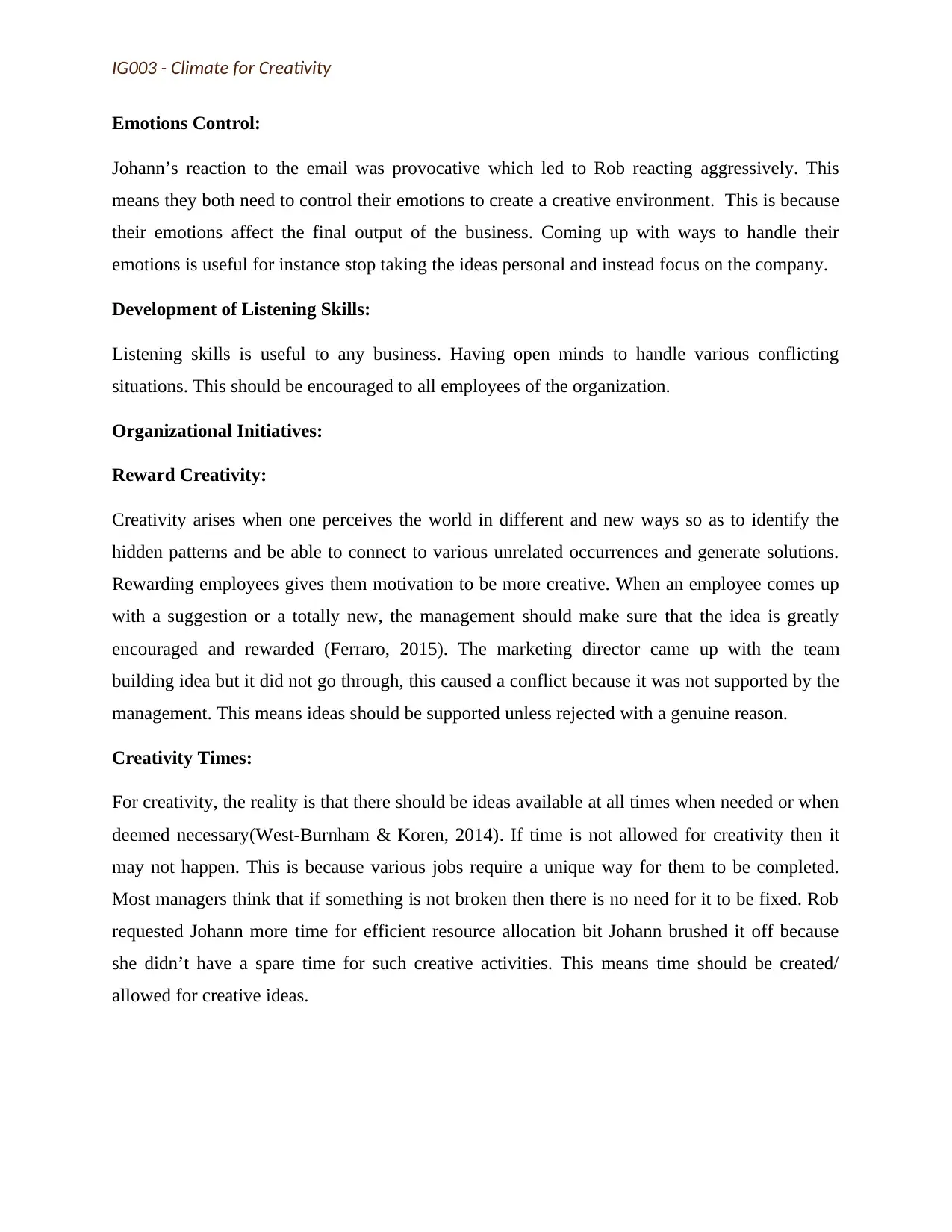
IG003 - Climate for Creativity
Emotions Control:
Johann’s reaction to the email was provocative which led to Rob reacting aggressively. This
means they both need to control their emotions to create a creative environment. This is because
their emotions affect the final output of the business. Coming up with ways to handle their
emotions is useful for instance stop taking the ideas personal and instead focus on the company.
Development of Listening Skills:
Listening skills is useful to any business. Having open minds to handle various conflicting
situations. This should be encouraged to all employees of the organization.
Organizational Initiatives:
Reward Creativity:
Creativity arises when one perceives the world in different and new ways so as to identify the
hidden patterns and be able to connect to various unrelated occurrences and generate solutions.
Rewarding employees gives them motivation to be more creative. When an employee comes up
with a suggestion or a totally new, the management should make sure that the idea is greatly
encouraged and rewarded (Ferraro, 2015). The marketing director came up with the team
building idea but it did not go through, this caused a conflict because it was not supported by the
management. This means ideas should be supported unless rejected with a genuine reason.
Creativity Times:
For creativity, the reality is that there should be ideas available at all times when needed or when
deemed necessary(West-Burnham & Koren, 2014). If time is not allowed for creativity then it
may not happen. This is because various jobs require a unique way for them to be completed.
Most managers think that if something is not broken then there is no need for it to be fixed. Rob
requested Johann more time for efficient resource allocation bit Johann brushed it off because
she didn’t have a spare time for such creative activities. This means time should be created/
allowed for creative ideas.
Emotions Control:
Johann’s reaction to the email was provocative which led to Rob reacting aggressively. This
means they both need to control their emotions to create a creative environment. This is because
their emotions affect the final output of the business. Coming up with ways to handle their
emotions is useful for instance stop taking the ideas personal and instead focus on the company.
Development of Listening Skills:
Listening skills is useful to any business. Having open minds to handle various conflicting
situations. This should be encouraged to all employees of the organization.
Organizational Initiatives:
Reward Creativity:
Creativity arises when one perceives the world in different and new ways so as to identify the
hidden patterns and be able to connect to various unrelated occurrences and generate solutions.
Rewarding employees gives them motivation to be more creative. When an employee comes up
with a suggestion or a totally new, the management should make sure that the idea is greatly
encouraged and rewarded (Ferraro, 2015). The marketing director came up with the team
building idea but it did not go through, this caused a conflict because it was not supported by the
management. This means ideas should be supported unless rejected with a genuine reason.
Creativity Times:
For creativity, the reality is that there should be ideas available at all times when needed or when
deemed necessary(West-Burnham & Koren, 2014). If time is not allowed for creativity then it
may not happen. This is because various jobs require a unique way for them to be completed.
Most managers think that if something is not broken then there is no need for it to be fixed. Rob
requested Johann more time for efficient resource allocation bit Johann brushed it off because
she didn’t have a spare time for such creative activities. This means time should be created/
allowed for creative ideas.
⊘ This is a preview!⊘
Do you want full access?
Subscribe today to unlock all pages.

Trusted by 1+ million students worldwide

IG003 - Climate for Creativity
Encouraging Team Work:
Team work enables various dreams to come true. Sharing of ideas with others in the team
enables the ideas to be discussed. Team work is useful in resolving issues in the organization as
well as giving insights to new ideas (Weberg, 2010). When various people have an additional
input into decisions, they are highly impacted by other people’s actions.
Conclusion
In conclusion, creativity impacts both environmental and creative world. In order to sustain and
grow the revenues of the organization, employees and managers ought to be open to new
thoughts. Innovation and creativity in any business results in positive influence for the
organization/ any business. These cultures should then be promoted and encouraged so as to aid
in the growth of the organization as well as enhancing good relationships among the workers.
Encouraging Team Work:
Team work enables various dreams to come true. Sharing of ideas with others in the team
enables the ideas to be discussed. Team work is useful in resolving issues in the organization as
well as giving insights to new ideas (Weberg, 2010). When various people have an additional
input into decisions, they are highly impacted by other people’s actions.
Conclusion
In conclusion, creativity impacts both environmental and creative world. In order to sustain and
grow the revenues of the organization, employees and managers ought to be open to new
thoughts. Innovation and creativity in any business results in positive influence for the
organization/ any business. These cultures should then be promoted and encouraged so as to aid
in the growth of the organization as well as enhancing good relationships among the workers.
Paraphrase This Document
Need a fresh take? Get an instant paraphrase of this document with our AI Paraphraser
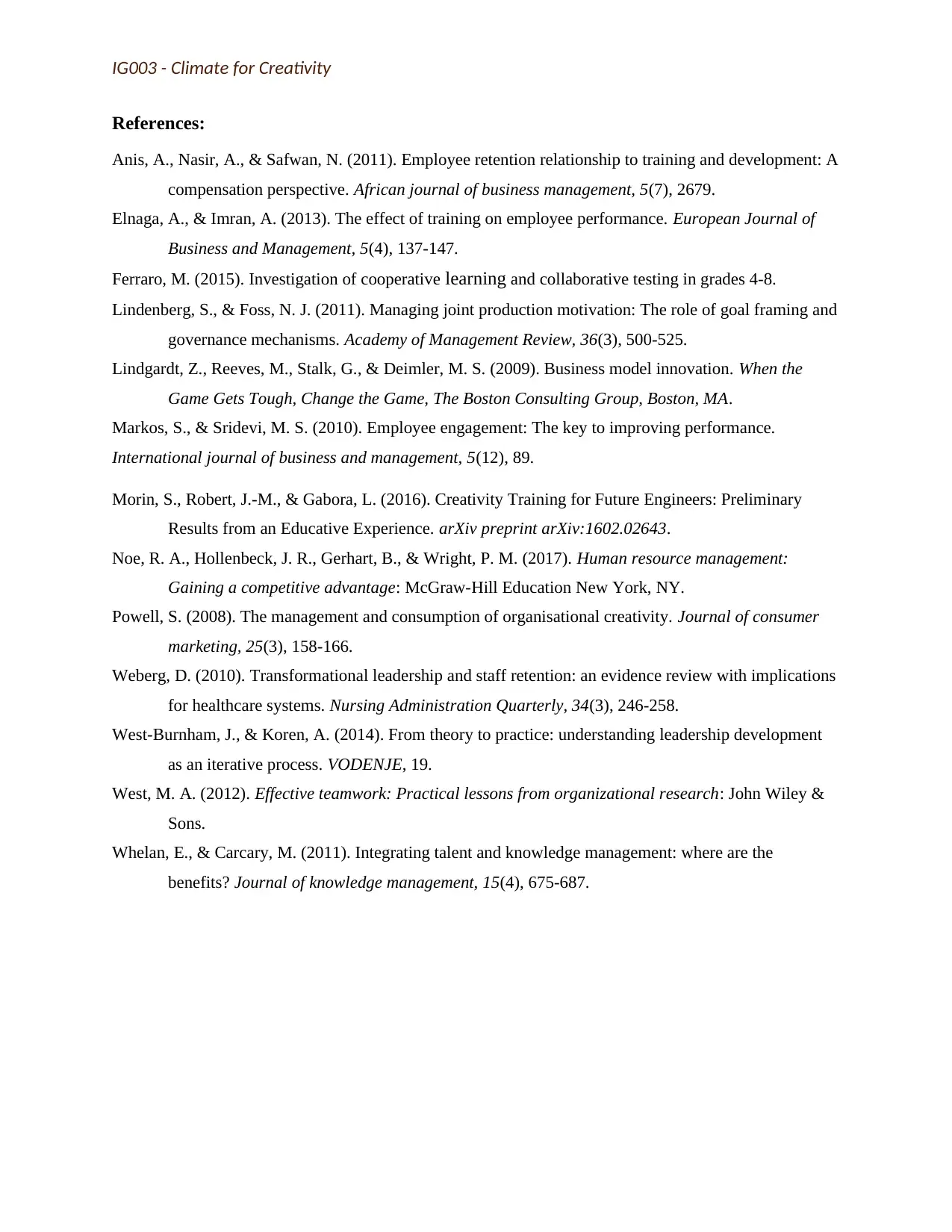
IG003 - Climate for Creativity
References:
Anis, A., Nasir, A., & Safwan, N. (2011). Employee retention relationship to training and development: A
compensation perspective. African journal of business management, 5(7), 2679.
Elnaga, A., & Imran, A. (2013). The effect of training on employee performance. European Journal of
Business and Management, 5(4), 137-147.
Ferraro, M. (2015). Investigation of cooperative learning and collaborative testing in grades 4-8.
Lindenberg, S., & Foss, N. J. (2011). Managing joint production motivation: The role of goal framing and
governance mechanisms. Academy of Management Review, 36(3), 500-525.
Lindgardt, Z., Reeves, M., Stalk, G., & Deimler, M. S. (2009). Business model innovation. When the
Game Gets Tough, Change the Game, The Boston Consulting Group, Boston, MA.
Markos, S., & Sridevi, M. S. (2010). Employee engagement: The key to improving performance.
International journal of business and management, 5(12), 89.
Morin, S., Robert, J.-M., & Gabora, L. (2016). Creativity Training for Future Engineers: Preliminary
Results from an Educative Experience. arXiv preprint arXiv:1602.02643.
Noe, R. A., Hollenbeck, J. R., Gerhart, B., & Wright, P. M. (2017). Human resource management:
Gaining a competitive advantage: McGraw-Hill Education New York, NY.
Powell, S. (2008). The management and consumption of organisational creativity. Journal of consumer
marketing, 25(3), 158-166.
Weberg, D. (2010). Transformational leadership and staff retention: an evidence review with implications
for healthcare systems. Nursing Administration Quarterly, 34(3), 246-258.
West-Burnham, J., & Koren, A. (2014). From theory to practice: understanding leadership development
as an iterative process. VODENJE, 19.
West, M. A. (2012). Effective teamwork: Practical lessons from organizational research: John Wiley &
Sons.
Whelan, E., & Carcary, M. (2011). Integrating talent and knowledge management: where are the
benefits? Journal of knowledge management, 15(4), 675-687.
References:
Anis, A., Nasir, A., & Safwan, N. (2011). Employee retention relationship to training and development: A
compensation perspective. African journal of business management, 5(7), 2679.
Elnaga, A., & Imran, A. (2013). The effect of training on employee performance. European Journal of
Business and Management, 5(4), 137-147.
Ferraro, M. (2015). Investigation of cooperative learning and collaborative testing in grades 4-8.
Lindenberg, S., & Foss, N. J. (2011). Managing joint production motivation: The role of goal framing and
governance mechanisms. Academy of Management Review, 36(3), 500-525.
Lindgardt, Z., Reeves, M., Stalk, G., & Deimler, M. S. (2009). Business model innovation. When the
Game Gets Tough, Change the Game, The Boston Consulting Group, Boston, MA.
Markos, S., & Sridevi, M. S. (2010). Employee engagement: The key to improving performance.
International journal of business and management, 5(12), 89.
Morin, S., Robert, J.-M., & Gabora, L. (2016). Creativity Training for Future Engineers: Preliminary
Results from an Educative Experience. arXiv preprint arXiv:1602.02643.
Noe, R. A., Hollenbeck, J. R., Gerhart, B., & Wright, P. M. (2017). Human resource management:
Gaining a competitive advantage: McGraw-Hill Education New York, NY.
Powell, S. (2008). The management and consumption of organisational creativity. Journal of consumer
marketing, 25(3), 158-166.
Weberg, D. (2010). Transformational leadership and staff retention: an evidence review with implications
for healthcare systems. Nursing Administration Quarterly, 34(3), 246-258.
West-Burnham, J., & Koren, A. (2014). From theory to practice: understanding leadership development
as an iterative process. VODENJE, 19.
West, M. A. (2012). Effective teamwork: Practical lessons from organizational research: John Wiley &
Sons.
Whelan, E., & Carcary, M. (2011). Integrating talent and knowledge management: where are the
benefits? Journal of knowledge management, 15(4), 675-687.
1 out of 8
Related Documents
Your All-in-One AI-Powered Toolkit for Academic Success.
+13062052269
info@desklib.com
Available 24*7 on WhatsApp / Email
![[object Object]](/_next/static/media/star-bottom.7253800d.svg)
Unlock your academic potential
Copyright © 2020–2025 A2Z Services. All Rights Reserved. Developed and managed by ZUCOL.





